Tom's Hardware Verdict
The G.Skill Trident Z5 RGB DDR5-7200 C34 looks and overclocks as good as any DDR5-7200 memory kit. However, its strong out-of-the-box performance gives it an edge over the competition.
Pros
- +
Exemplary performance
- +
Good overclocking
Cons
- -
Doesn't come cheap
- -
Only compatible with Raptor Lake CPUs
Why you can trust Tom's Hardware
Today we're putting the G.Skill Trident Z5 RGB DDR5-7200 C34 memory kit to the test to see how it stacks up against the best RAM on the market. During the early days of DDR5, memory vendors didn't have a wide selection of dies for their memory kits. As a result, the first DDR5 products used SK hynix's M-die, Samsung's B-die, or Micron's M-die integrated circuits (ICs). No two dies are manufactured equally. It didn't take long for SK hynix's M-die to show its overclocking superiority over its competition. The M-die ICs effortlessly surpass rival ICs in overclocking. SK hynix has now developed the company's second-generation A-die ICs to further push DDR5 to its limits.
A-die isn't the replacement for M-die, though — SK hynix continues to manufacture both products in parallel. The ultra-fast DDR5 memory kits, specifically those higher than DDR5-7000, exploit the latest SK hynix A-die ICs. Until Micron and Samsung release something better, SK hynix's A-die ICs are currently the preferred dies for overclocking by many enthusiasts and performance seekers.
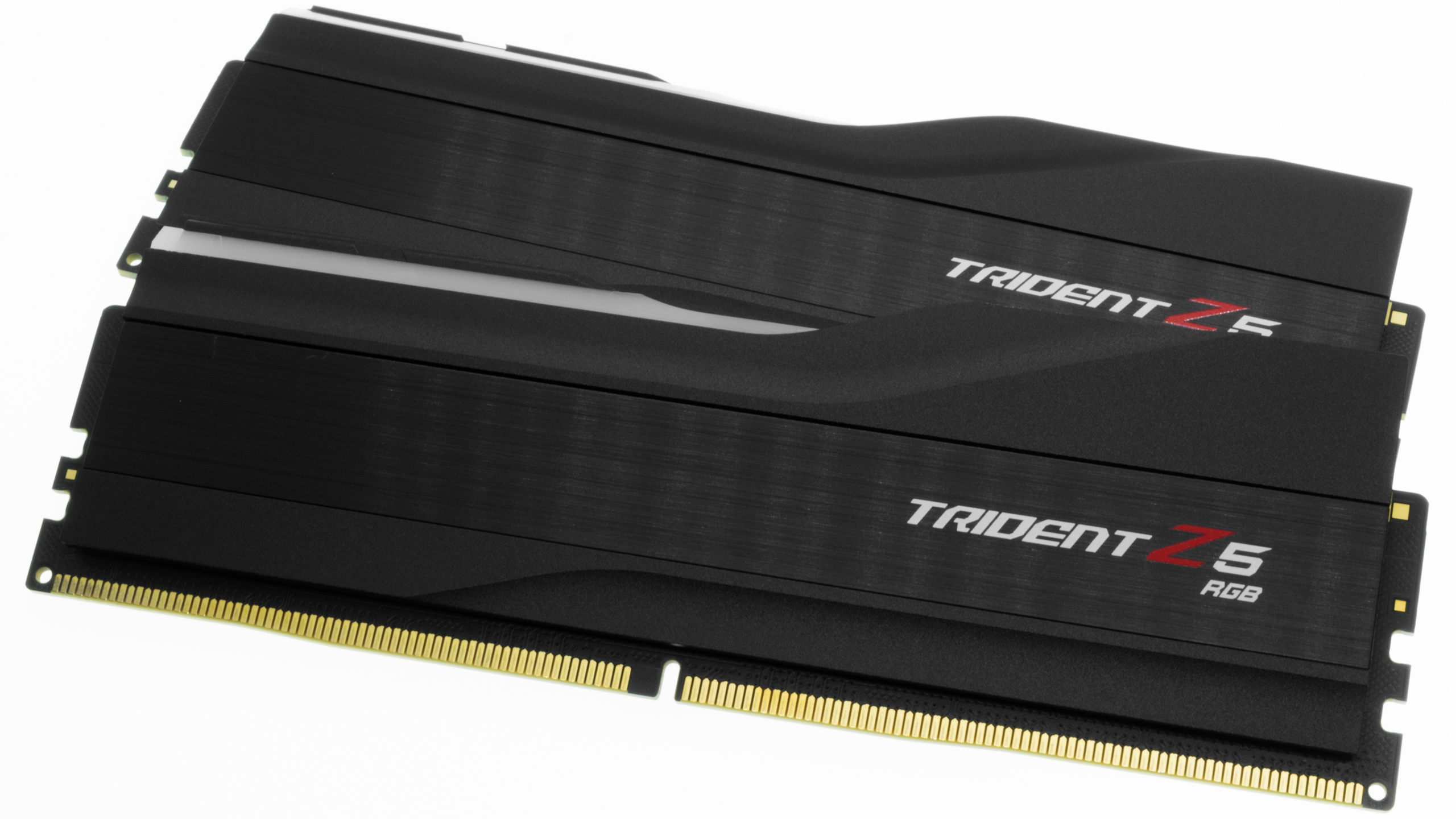
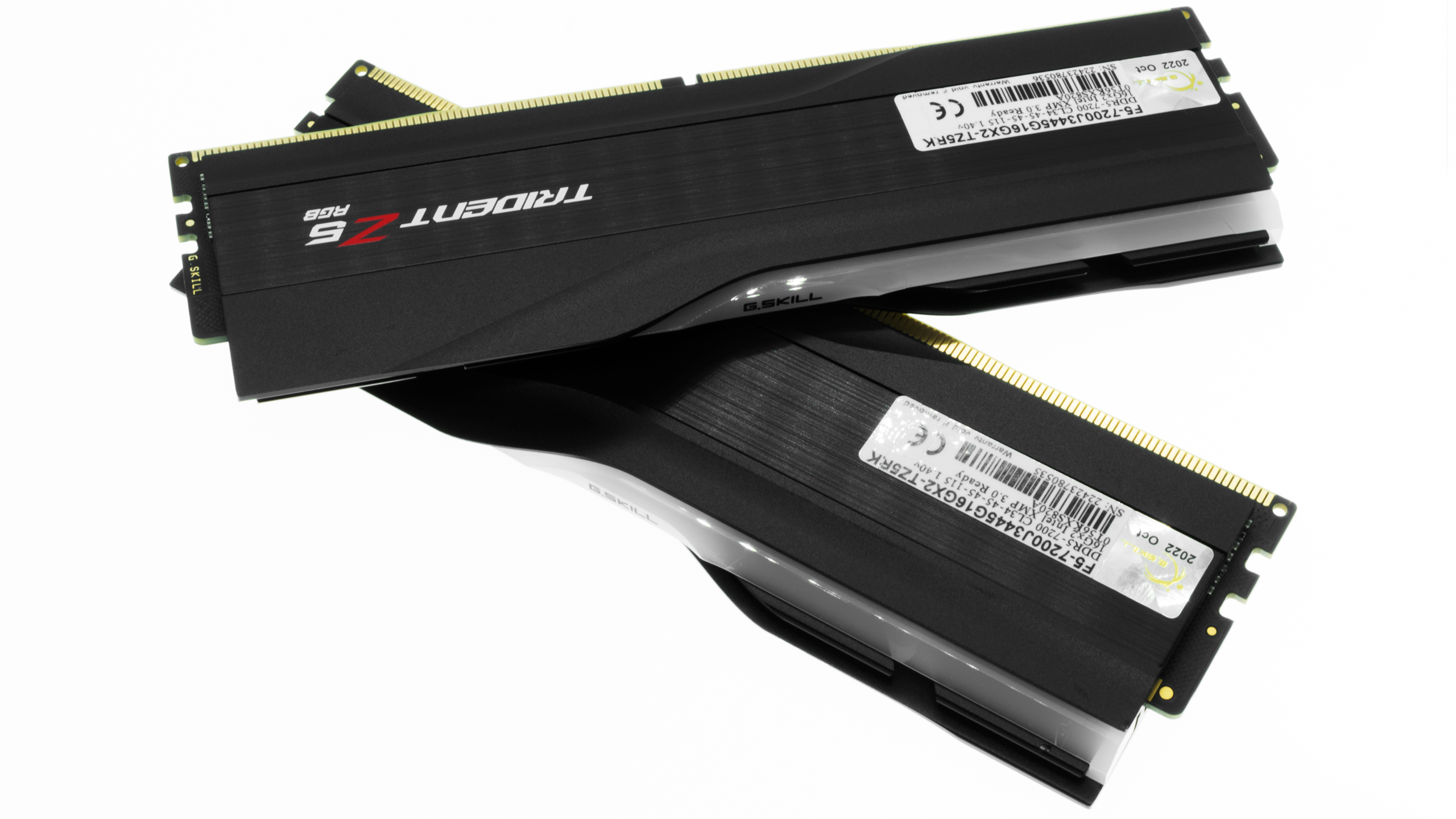
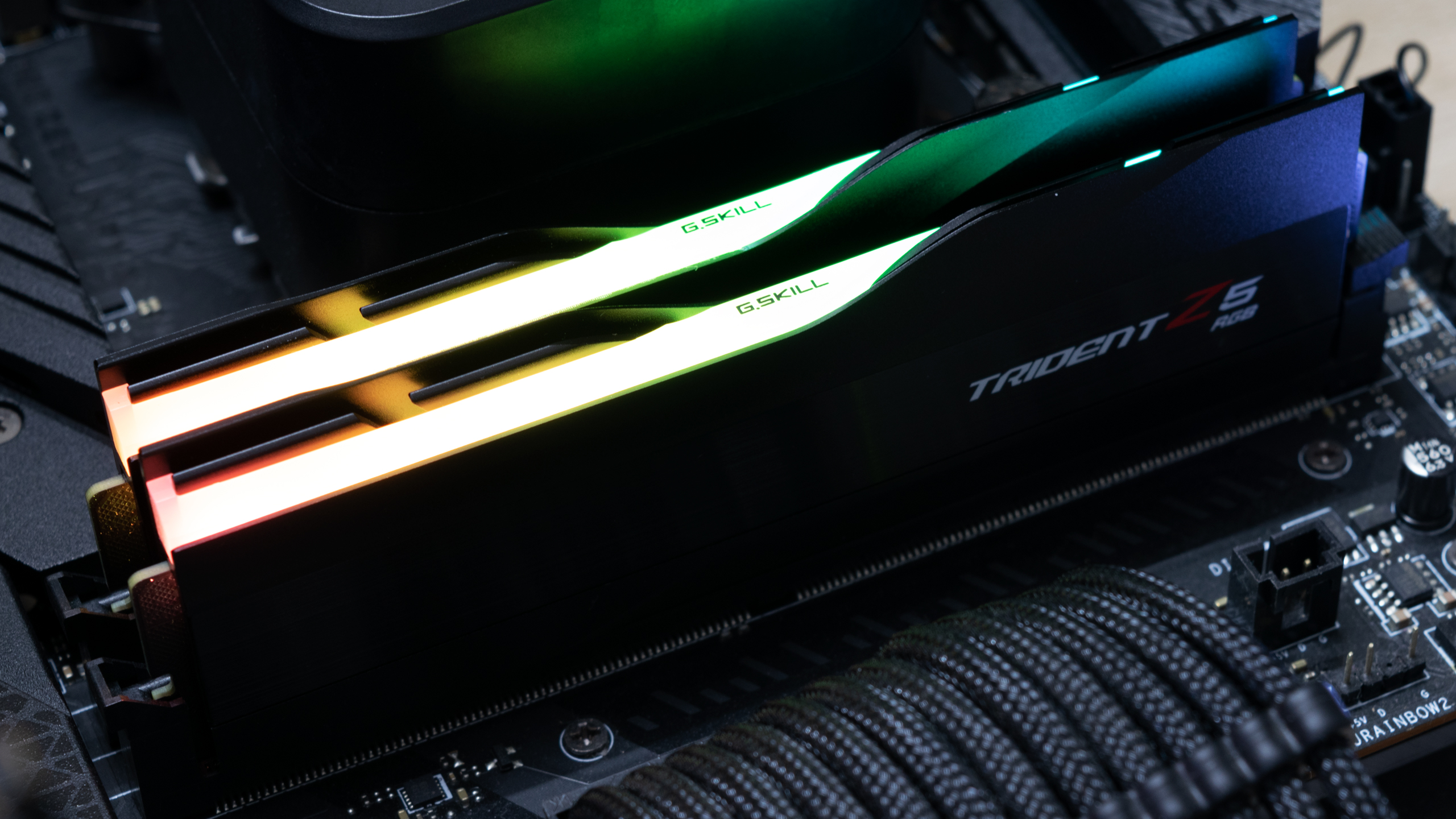
G.Skill hasn't drastically deviated from the Trident's core design over the last couple of generations, and it shows with the Trident Z5 RGB memory. It still features that familiar and aggressive fin-like exterior with sharp edges. The heat spreader, which is made of aluminum, has a matte black exterior and a middle strip with a brushed aluminum finish. G.Skill has many variations of the Trident Z5 design, but the memory modules conform to a height of 42mm (1.65 inches) for maximum compatibility with motherboards and CPU air coolers.
RGB lighting has become a requirement for gaming memory, and the Trident Z5 RGB sticks to the trend. The slim RGB light bar above the heat spreader shines vibrantly. There are two ways consumers can control it. If you're an avid fan of the brand, G.Skill provides the Trident Z Lighting Control software. If not, you can always control it with your motherboard's lighting software. Support extends to Asus Aura Sync, Gigabyte RGB Fusion 2.0, MSI Mystic Light Sync, and ASRock Polychrome Sync.
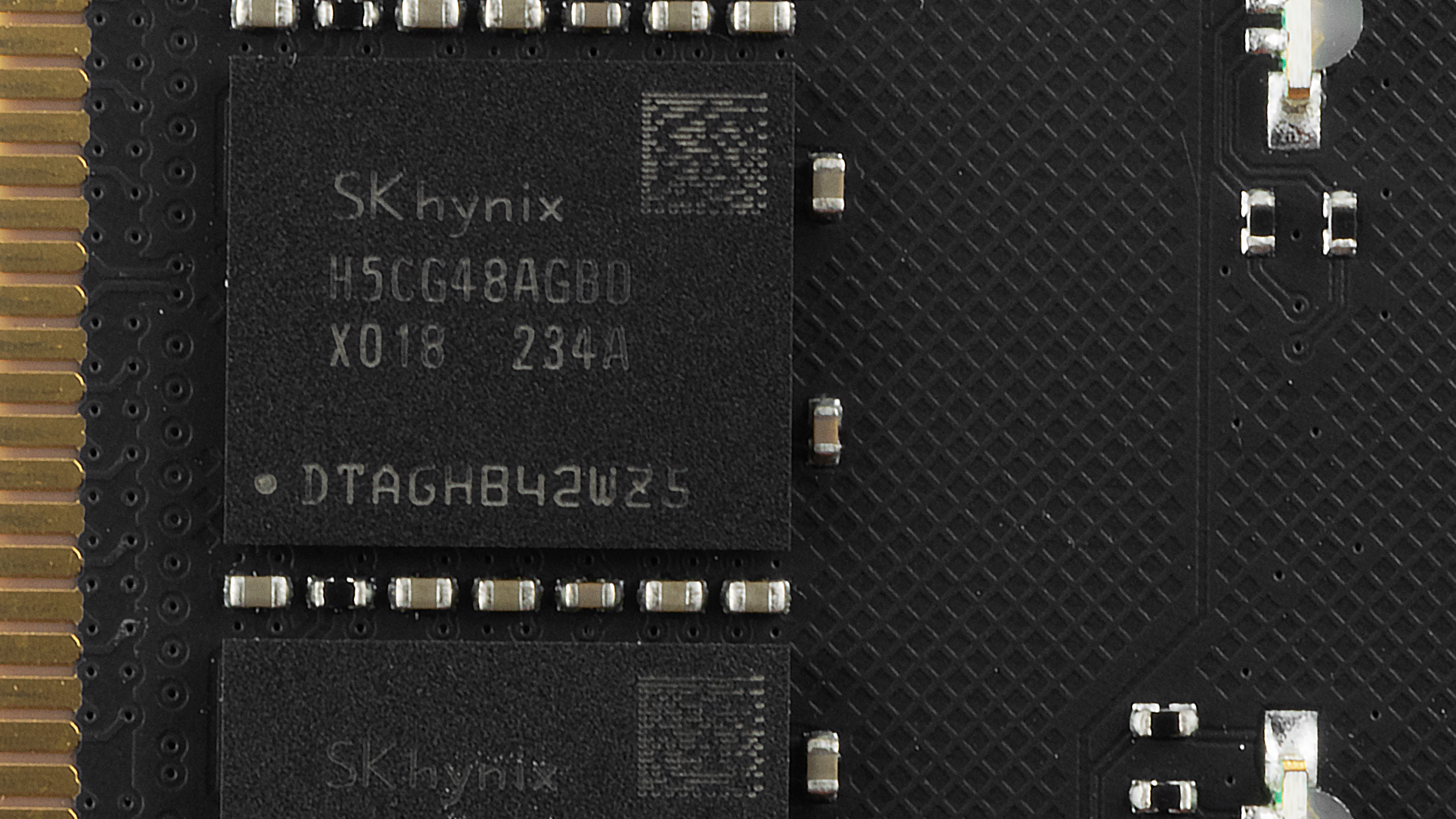
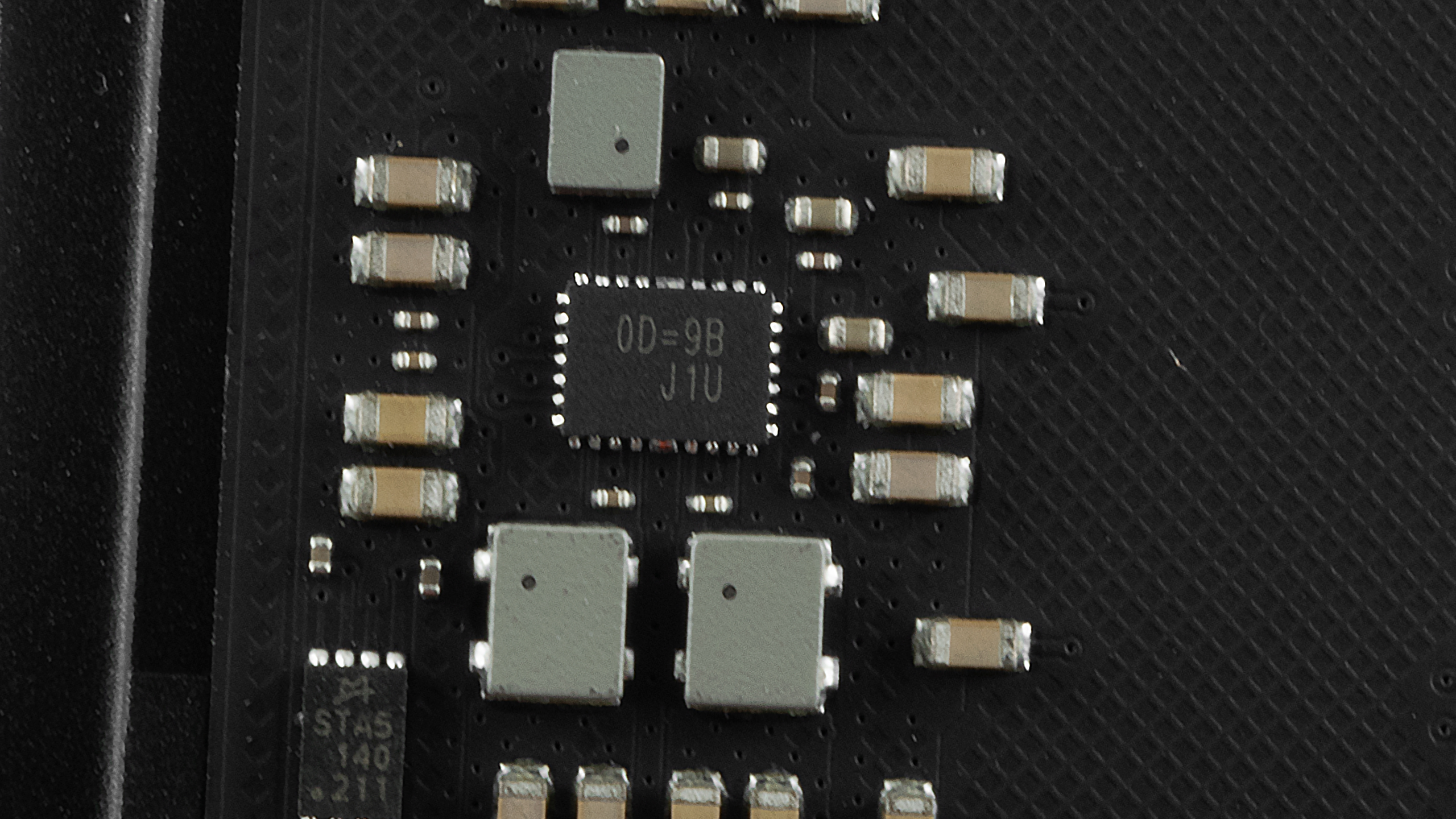
G.Skill hand-screened the SK hynix H5CG48AGBDX018 (A-die) ICs that went into memory modules. It's a single-rank design with eight 2GB chips, amounting to 16GB of capacity per memory module. Richtek's 0D=9B J1U power management IC (PMIC) is responsible for voltage regulation on the Trident Z5 RGB memory modules.
Some DDR5-7200 memory kits default to DDR5-5600 natively, but G.Skill's memory still adheres to DDR5-4800. The default timings are 40-40-40-77. G.Skill designed the memory kit for Intel's latest 13th Generation Raptor Lake processors, which arrives with Intel XMP 3.0 support. There's only one profile, and it stores the settings for DDR5-7200 with 34-45-45-115 timings at 1.4V. See our PC Memory 101 feature and How to Shop for RAM story for more timings and frequency considerations.
Comparison Hardware
| Memory Kit | Part Number | Capacity | Data Rate | Primary Timings | Voltage | Warranty |
|---|---|---|---|---|---|---|
| TeamGroup T-Force Delta RGB | FF3D532G7200HC34ADC01 | 2 x 16GB | DDR5-7200 (XMP) | 34-42-42-84 (2T) | 1.40 | Lifetime |
| G.Skill Trident Z5 RGB | F5-7200J3445G16GX2-TZ5RK | 2 x 16GB | DDR5-7200 (XMP) | 34-45-45-115 (2T) | 1.40 | Lifetime |
| Corsair Vengeance RGB | CMH32GX5M2X7000C34 | 2 x 16GB | DDR5-7000 (XMP) | 34-42-42-96 (2T) | 1.45 | Lifetime |
| G.Skill Trident Z5 RGB | F5-6800J3445G16GX2-TZ5RK | 2 x 16GB | DDR5-6800 (XMP) | 34-45-45-108 (2T) | 1.40 | Lifetime |
| Corsair Dominator Platinum RGB | CMT32GX5M2X6600C32 | 2 x 16GB | DDR5-6600 (XMP) | 32-39-39-76 (2T) | 1.40 | Lifetime |
| G.Skill Trident Z5 RGB | F5-6400J3239G16GX2-TZ5RK | 2 x 16GB | DDR5-6400 (XMP) | 32-39-39-102 (2T) | 1.40 | Lifetime |
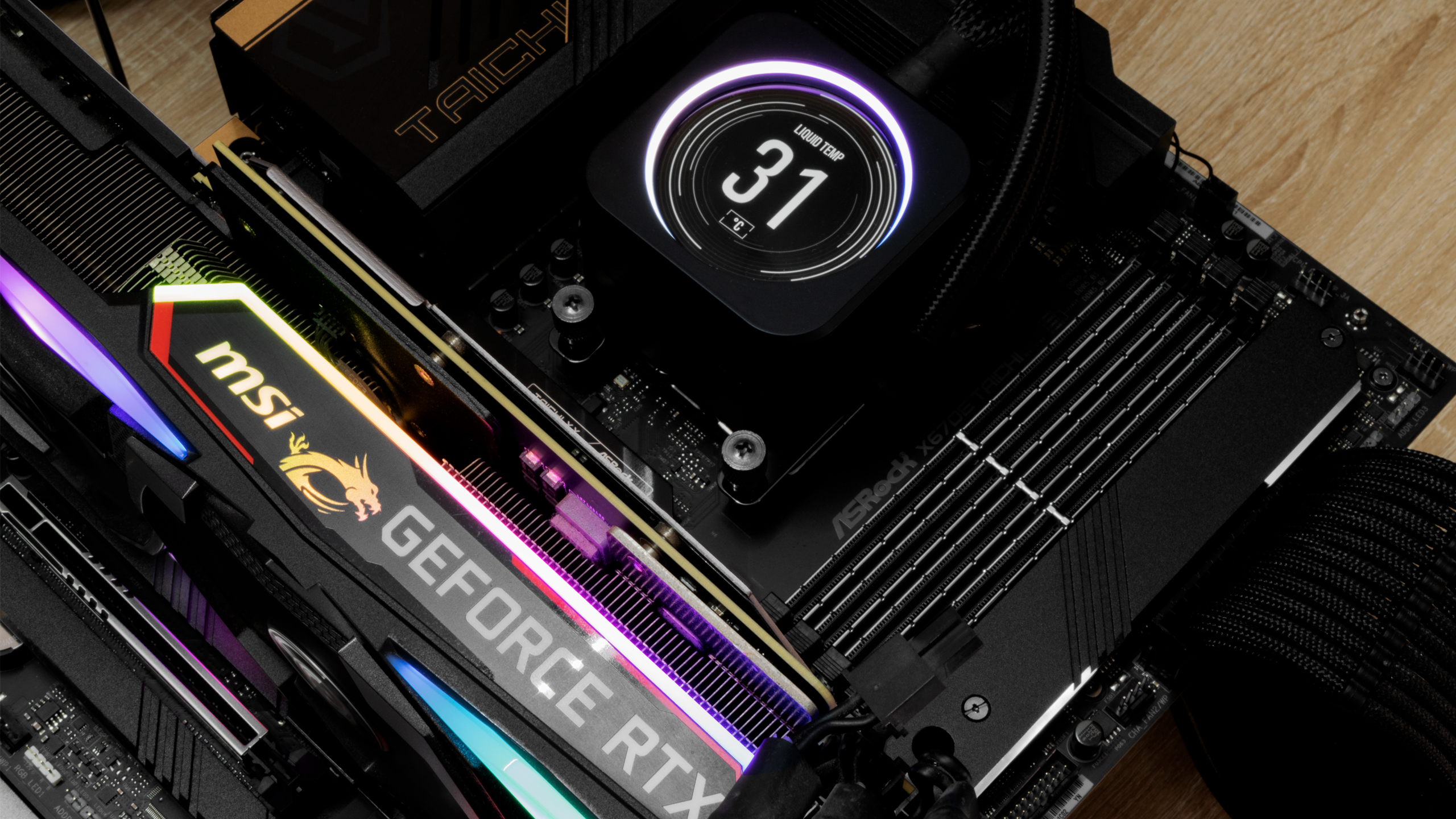
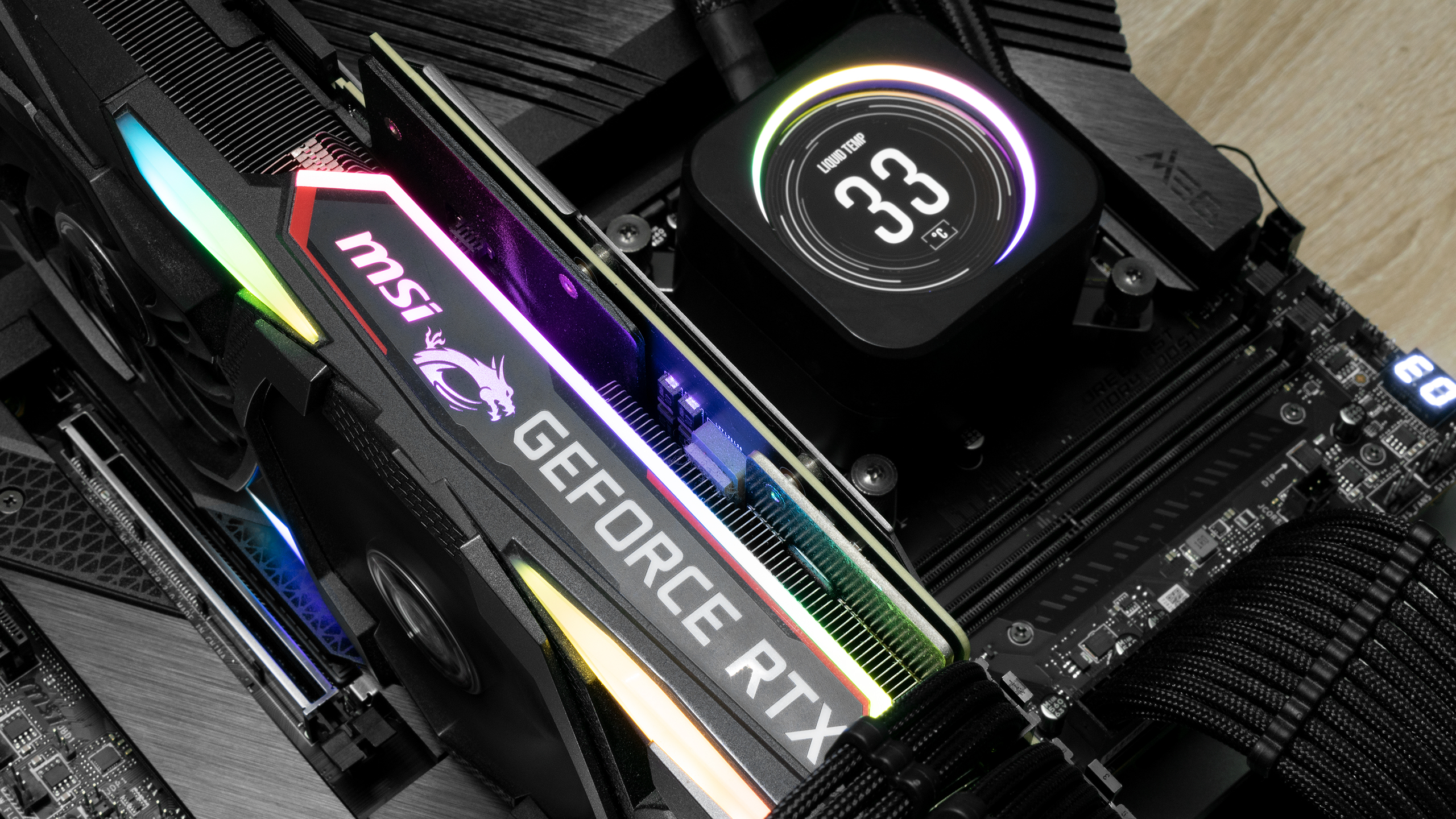
Our Intel test system revolves around Intel's Core i9-13900K processor and MSI's MEG Z690 Unify-X motherboard, running the 7D28vA8 firmware. In contrast, the AMD testbed leverages the Ryzen 7 7700X and ASRock X670E Taichi currently on the 1.11.AS06 firmware.
Corsair's CUE H100i Elite LCD liquid cooler keeps the Raptor Lake and Zen 4 processor temperatures in line. In addition, the MSI GeForce RTX 2080 Ti Gaming Trio tackles our gaming RAM benchmarks.
Our Windows 11 installation, benchmarking software, and games reside on Crucial's MX500 SSDs, whereas the Corsair RM650x power supply feeds our system with the necessary power. Lastly, the Streacom BC1 open bench table ensures that our hardware is well-kept and tidy.
| Component | Intel System | AMD System |
|---|---|---|
| Processor | Intel Core i9-13900K | AMD Ryzen 7 7700X |
| Motherboard | MSI MEG Z690 Unify-X | ASRock X670E Taichi |
| Graphics Card | MSI GeForce RTX 2080 Ti Gaming X Trio | MSI GeForce RTX 2080 Ti Gaming X Trio |
| Storage | Crucial MX500 500GB, 2TB | Crucial MX500 500GB, 2TB |
| Cooling | Corsair iCUE H100i Elite LCD | Corsair iCUE H100i Elite LCD |
| Power Supply | Corsair RM650x 650W | Corsair RM650x 650W |
| Case | Streacom BC1 | Streacom BC1 |
Intel Performance
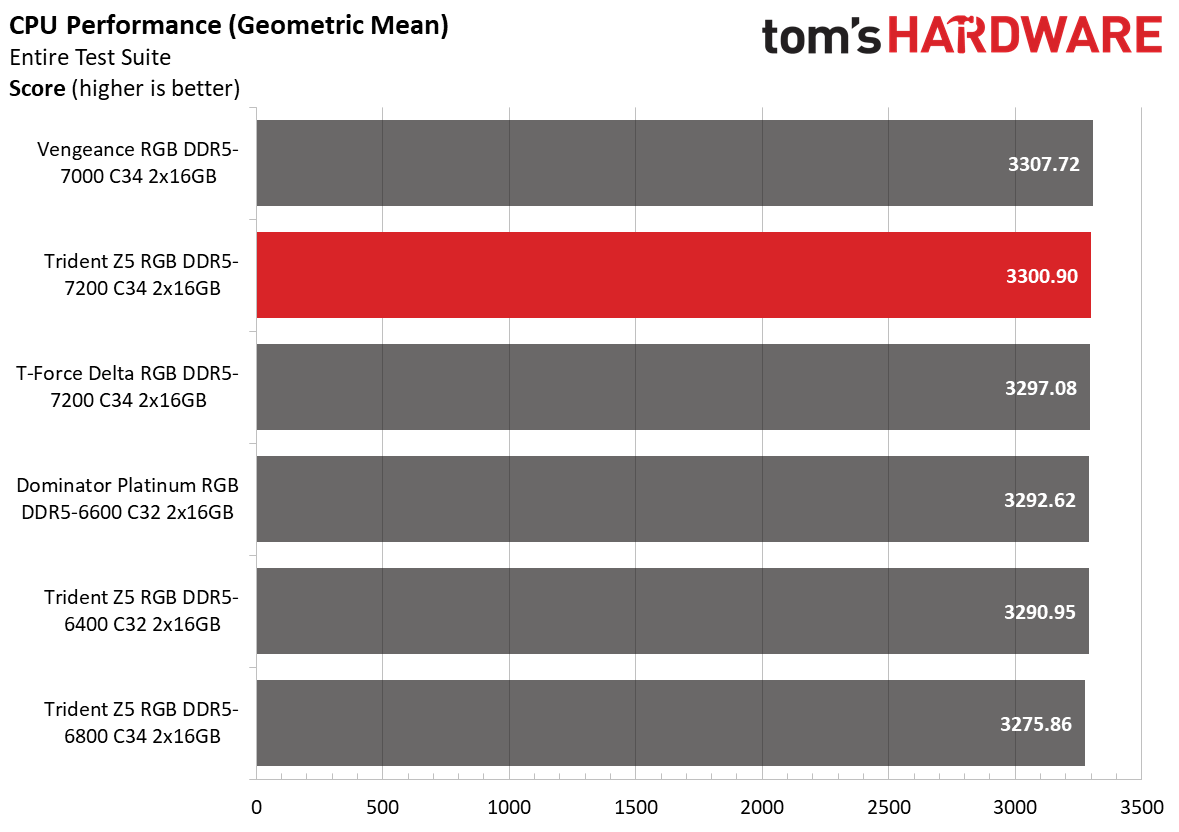
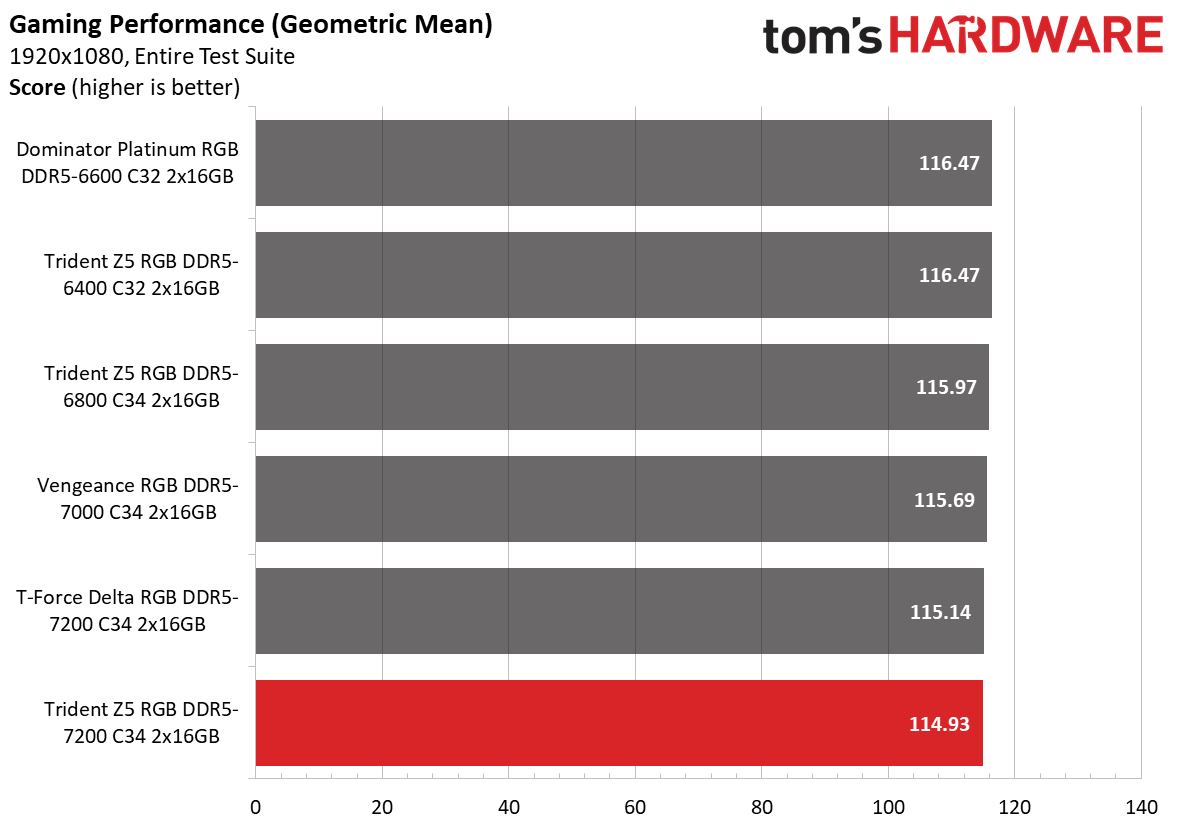
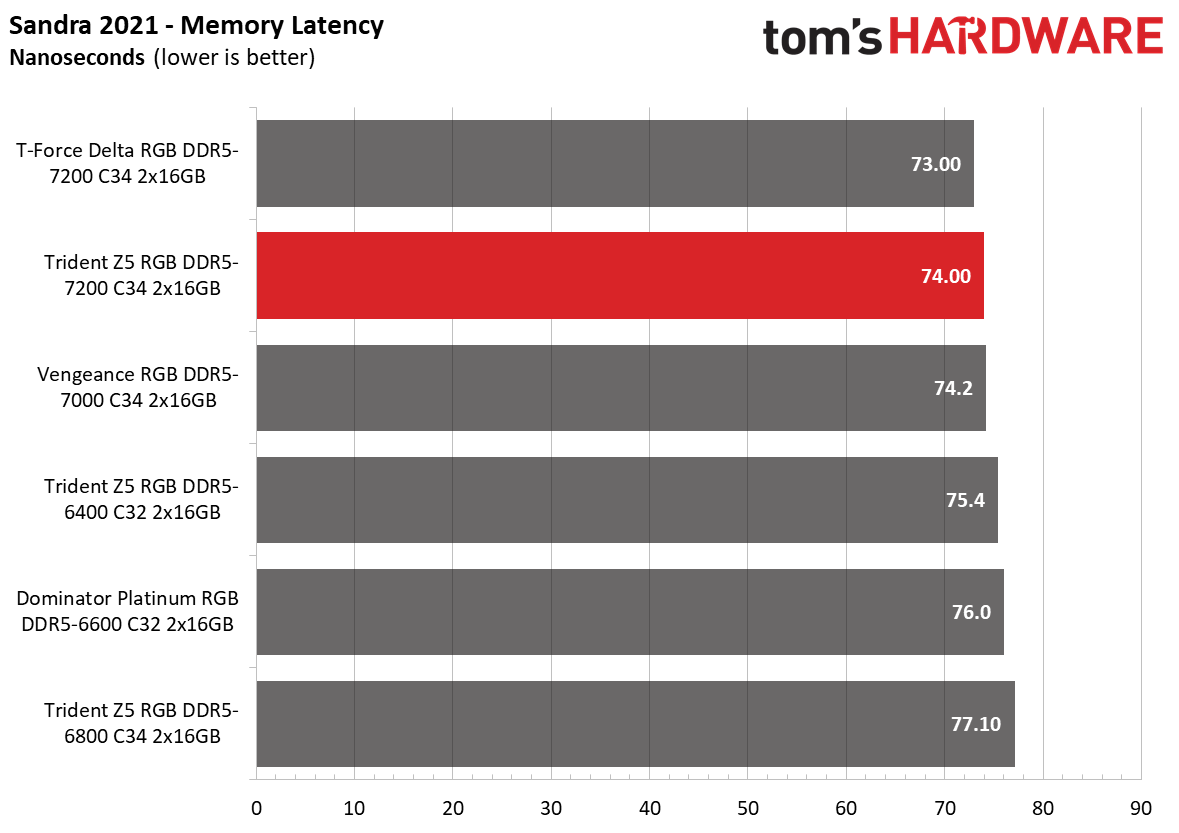
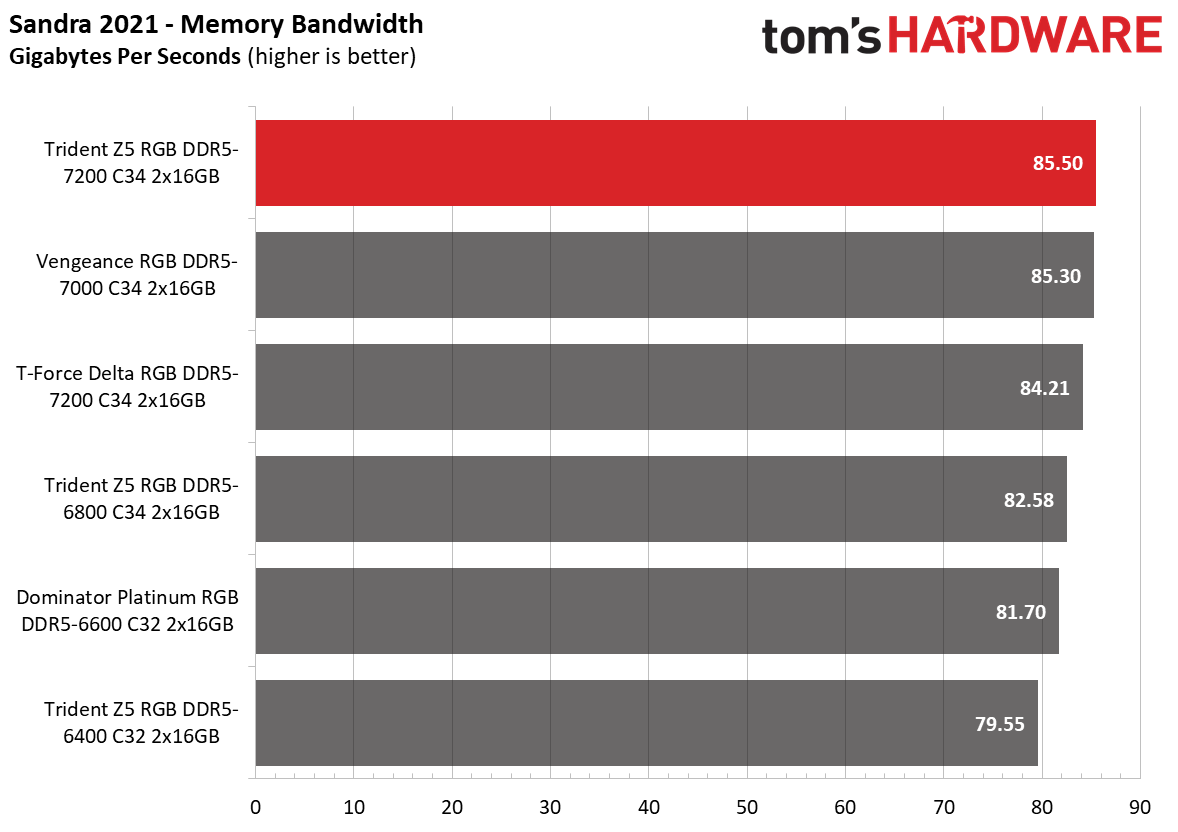
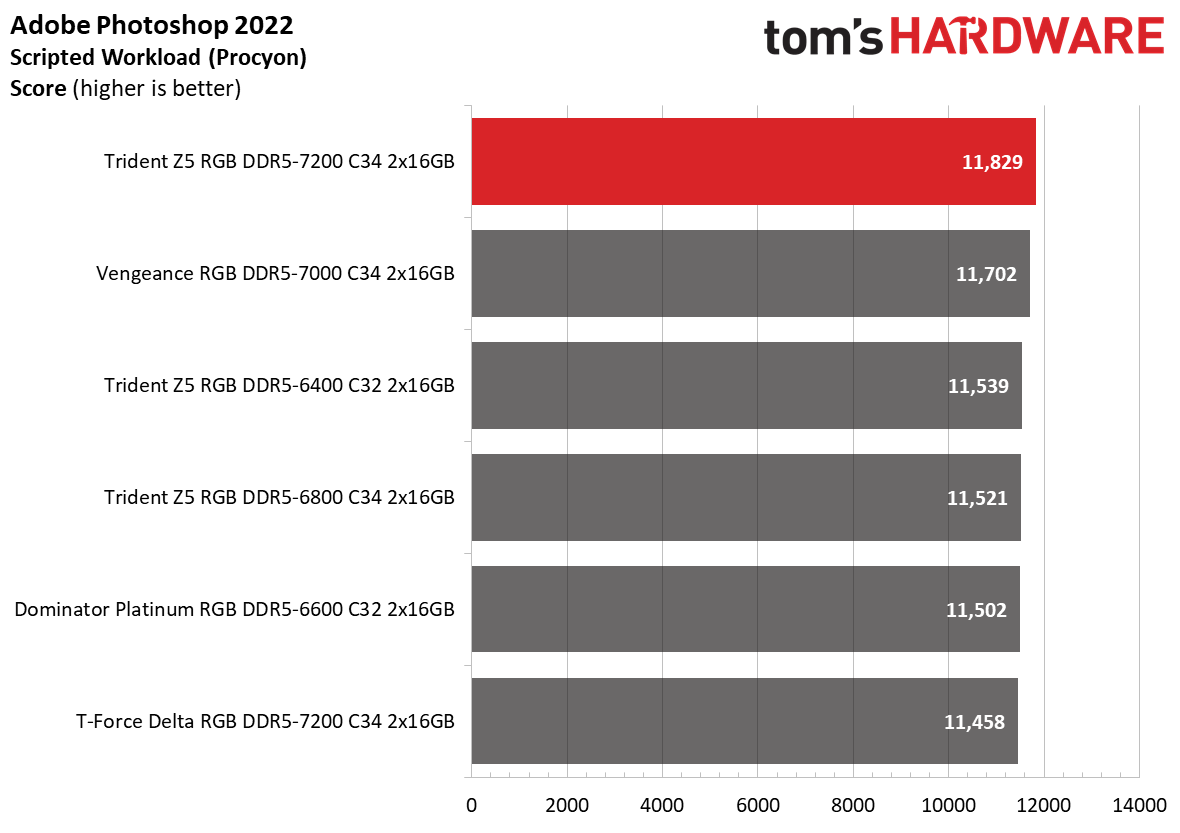
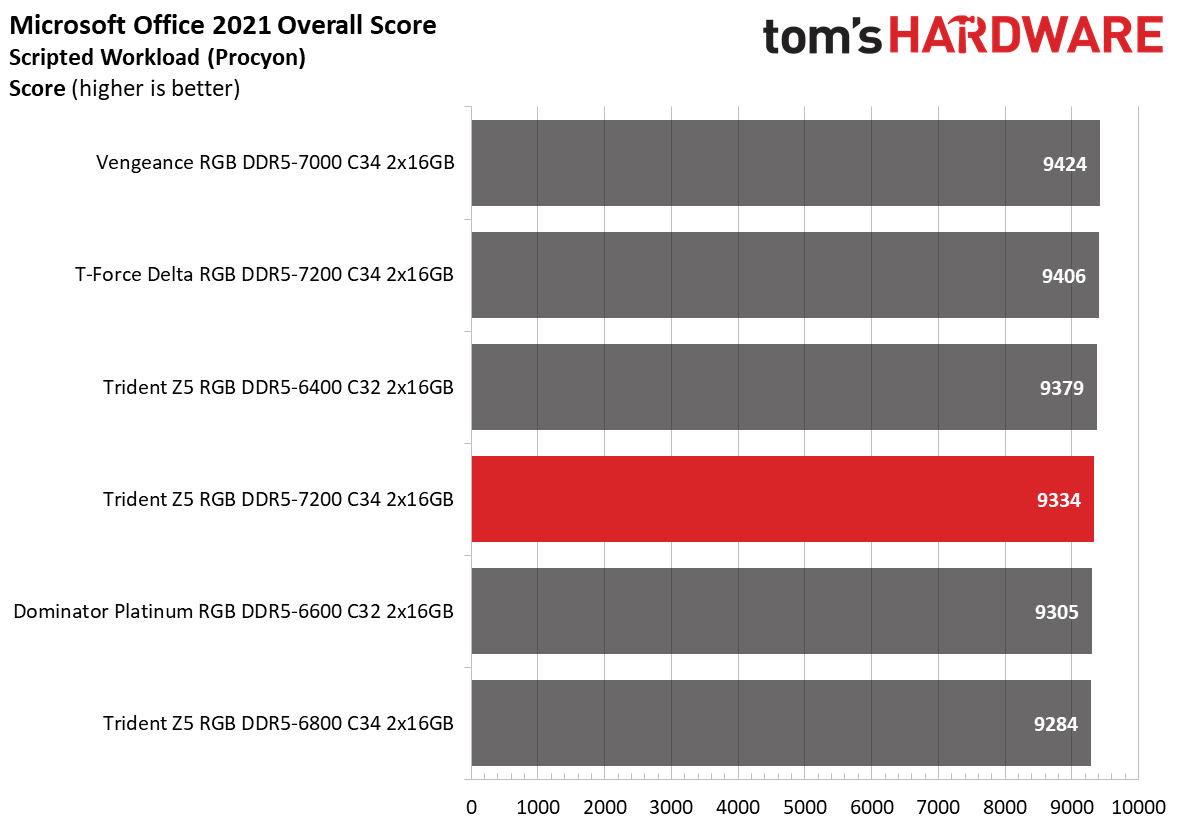
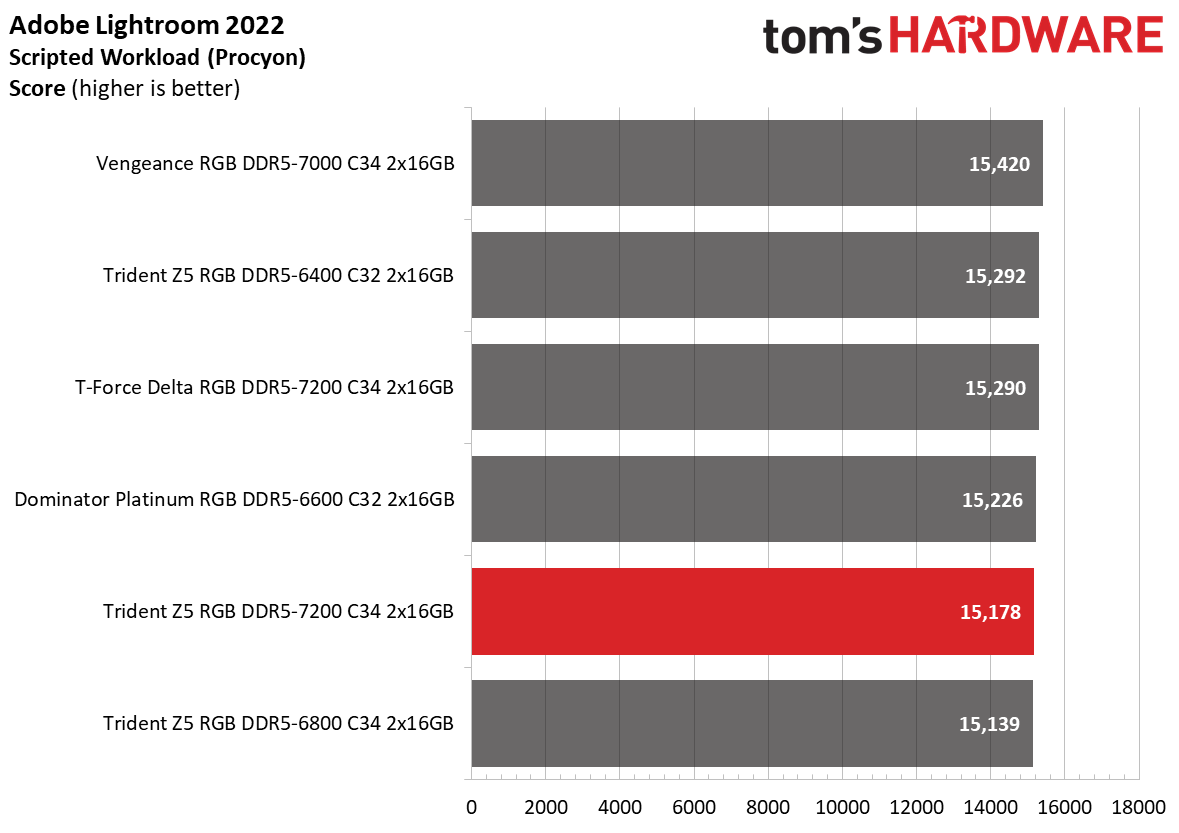
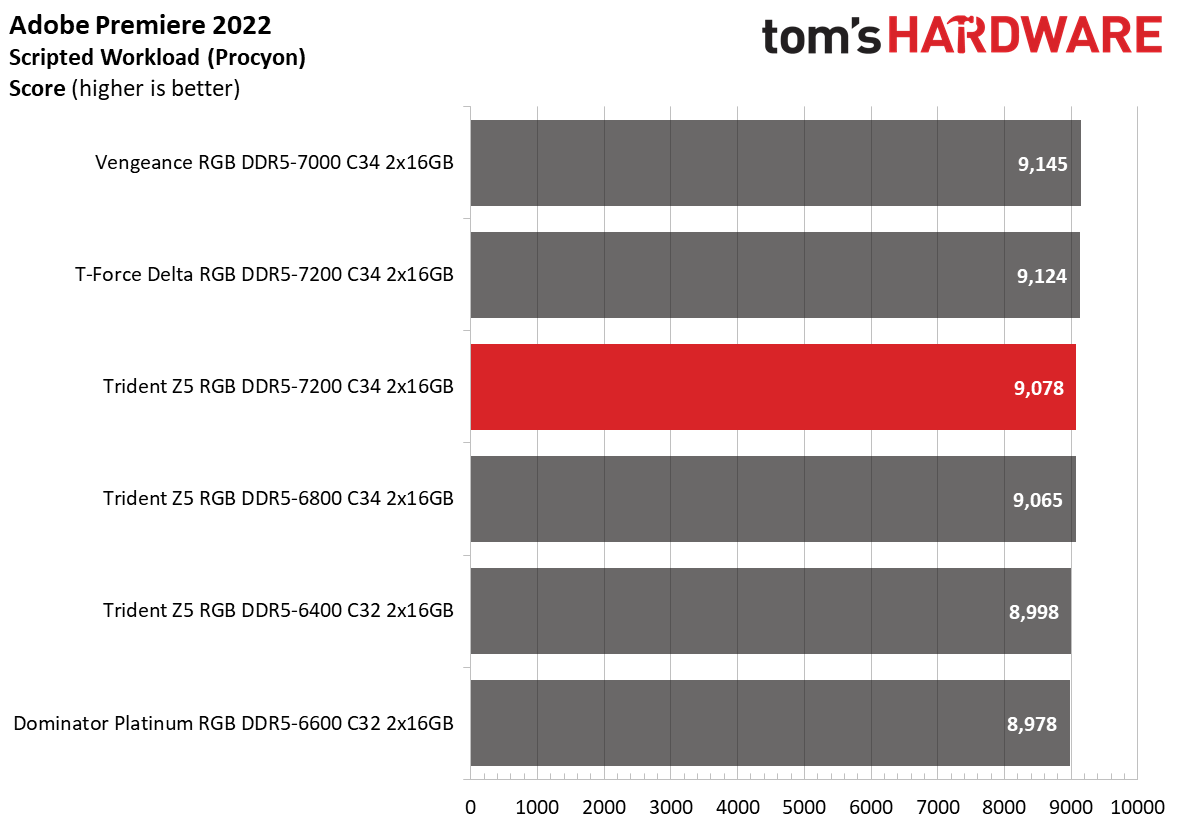
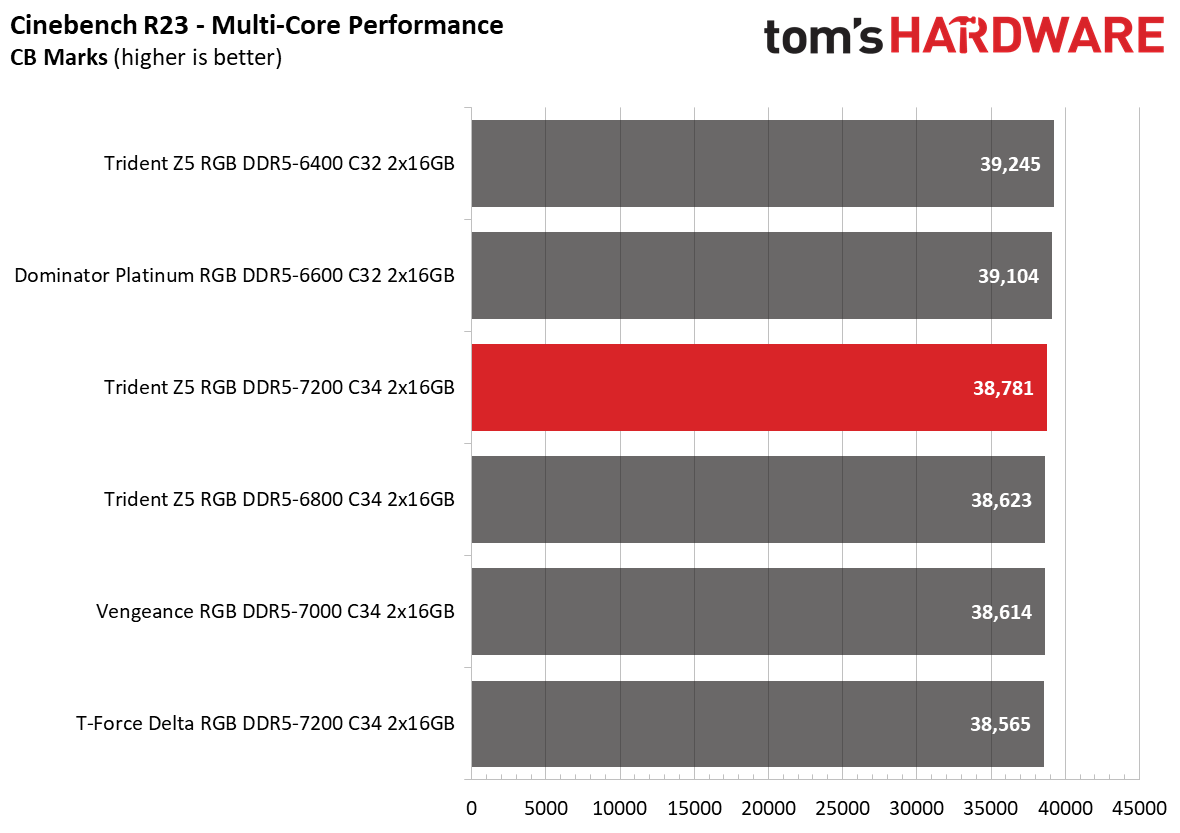
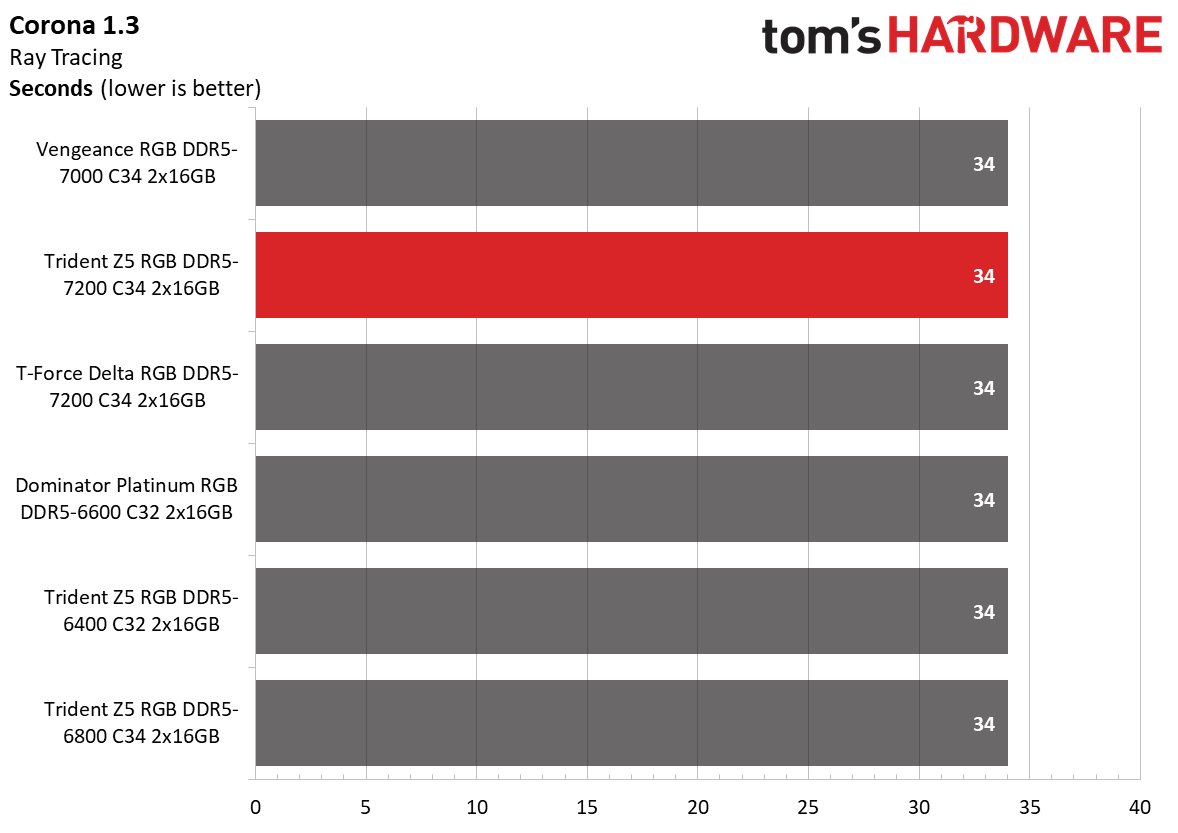
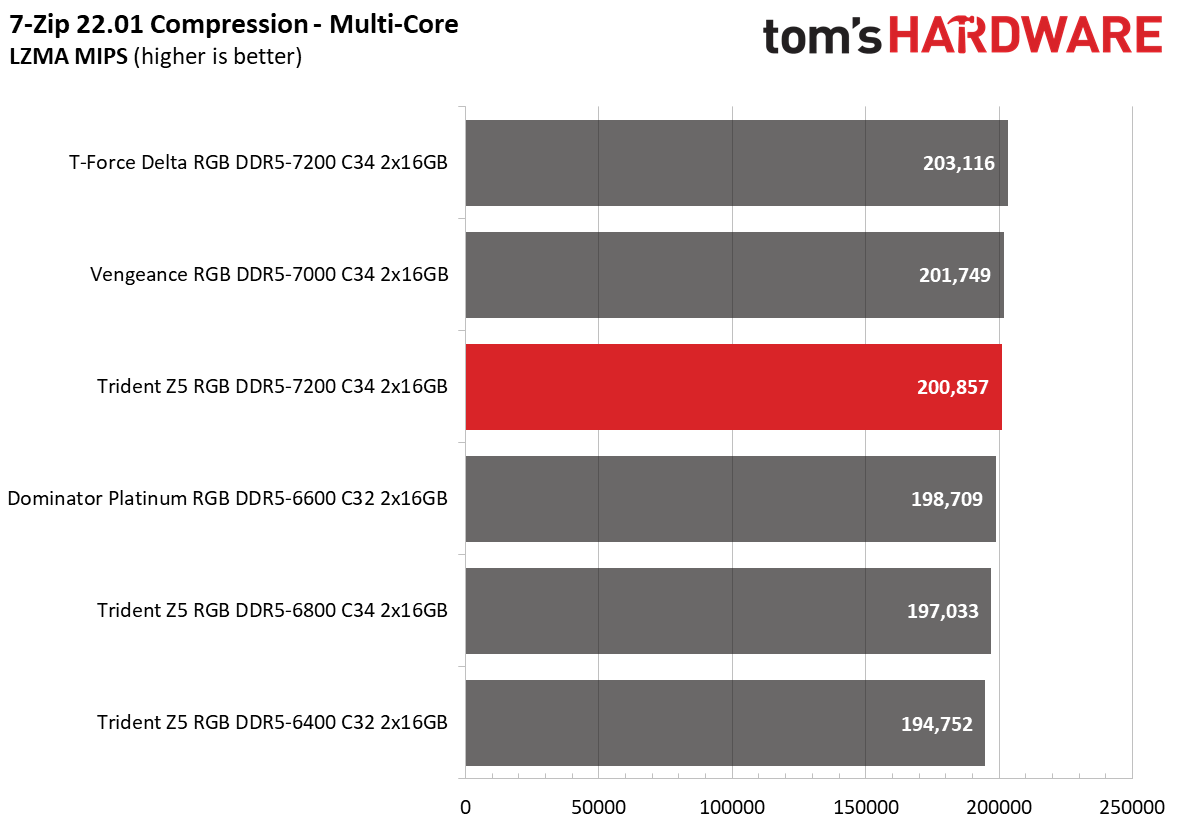
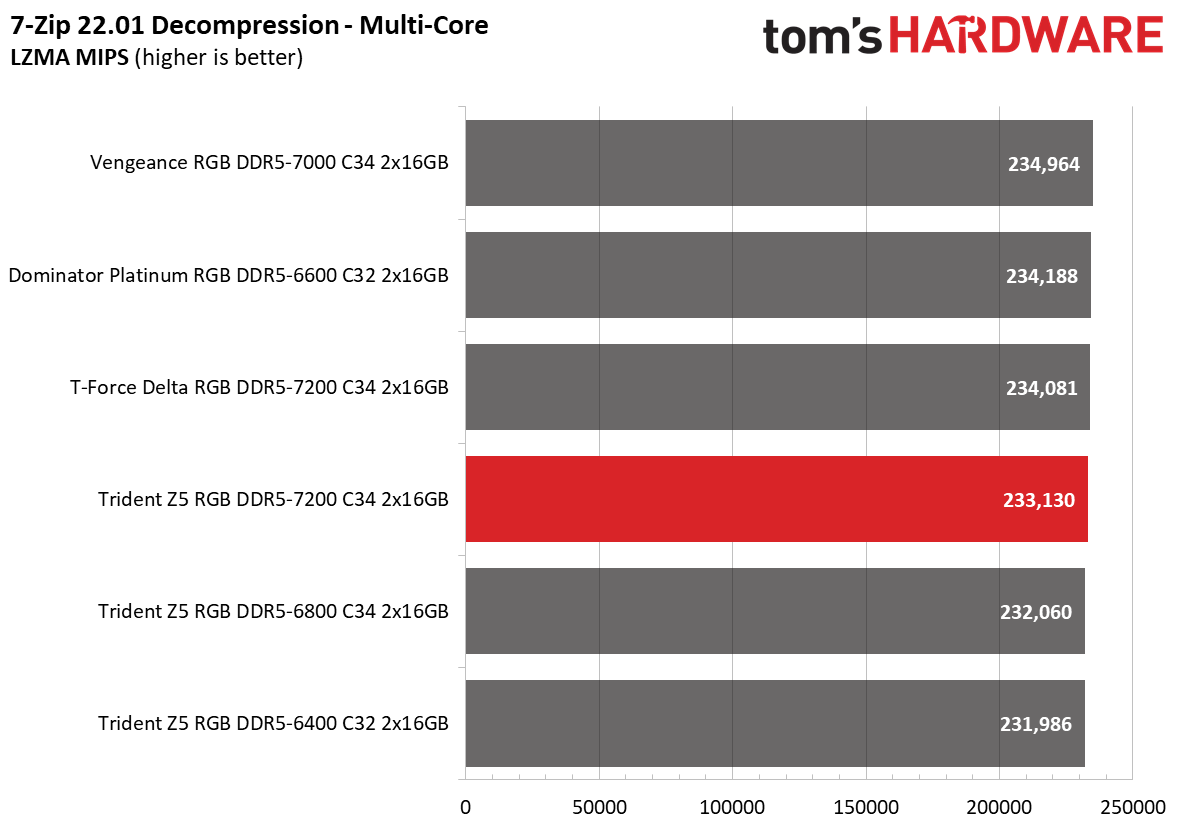
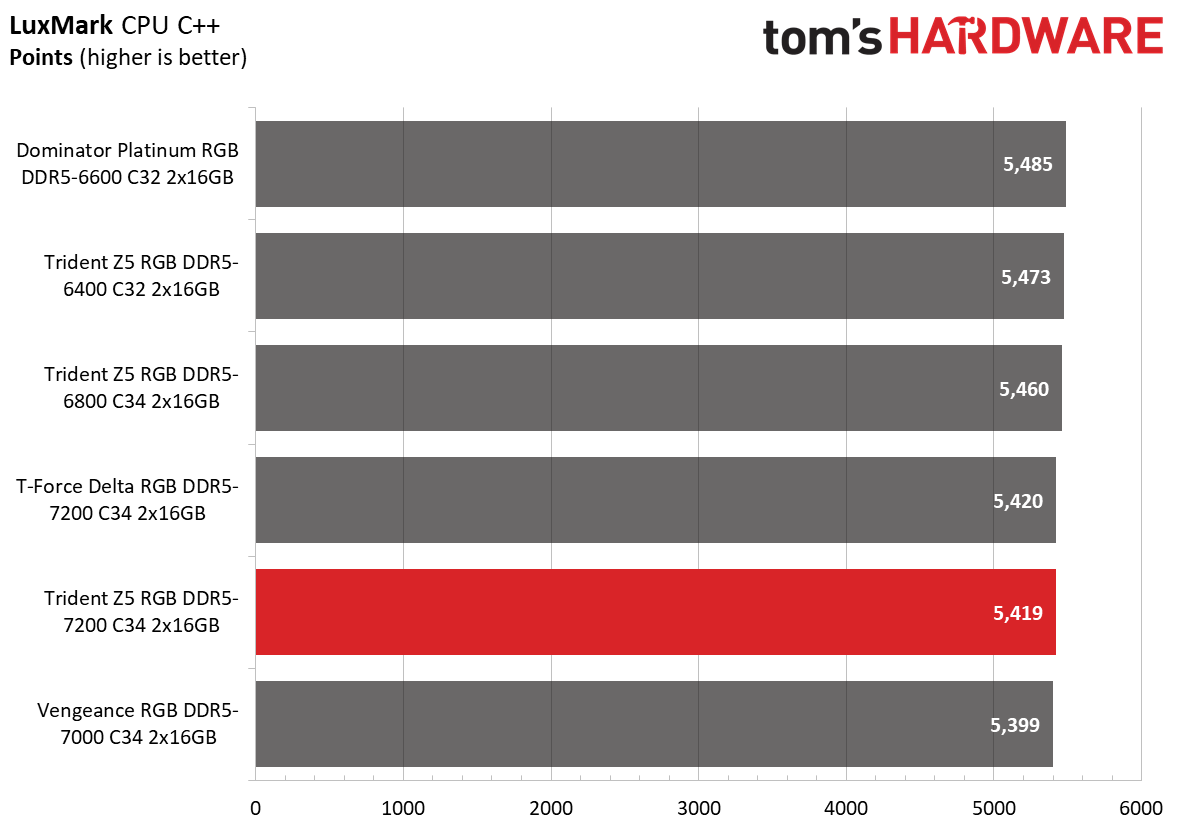
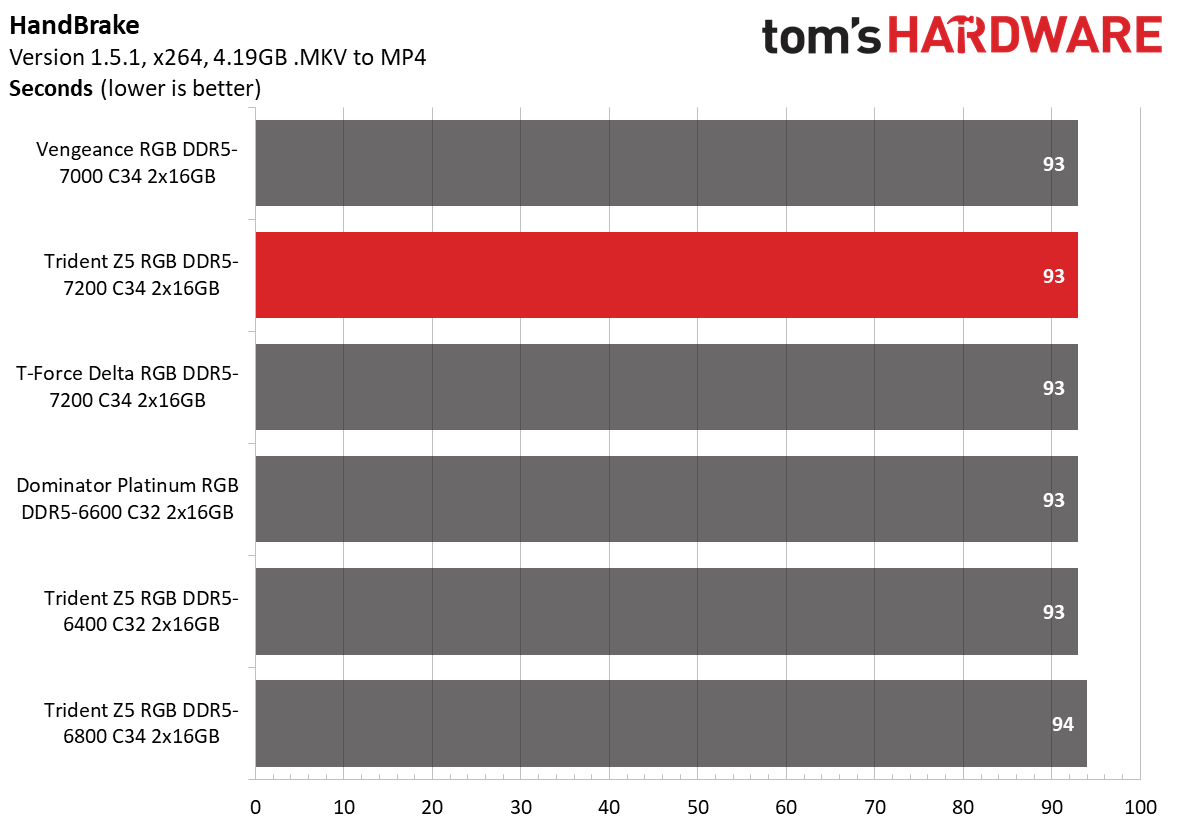
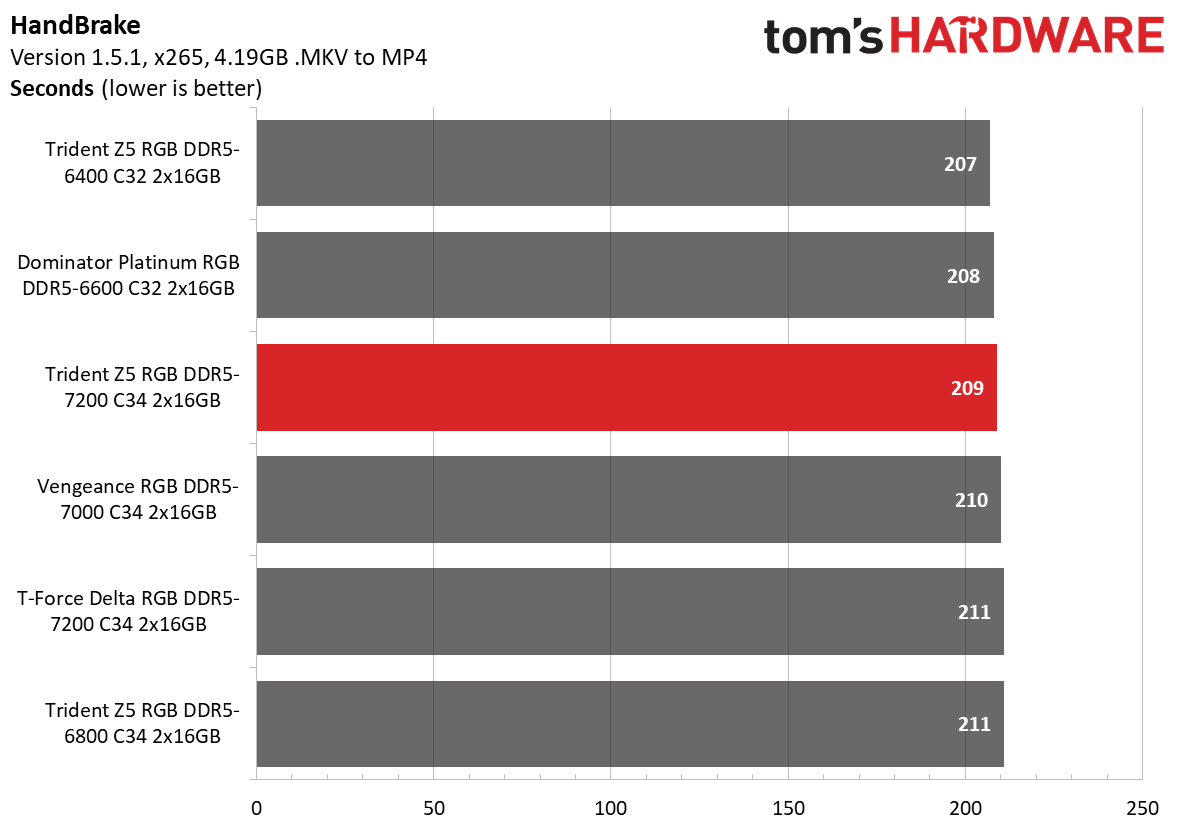
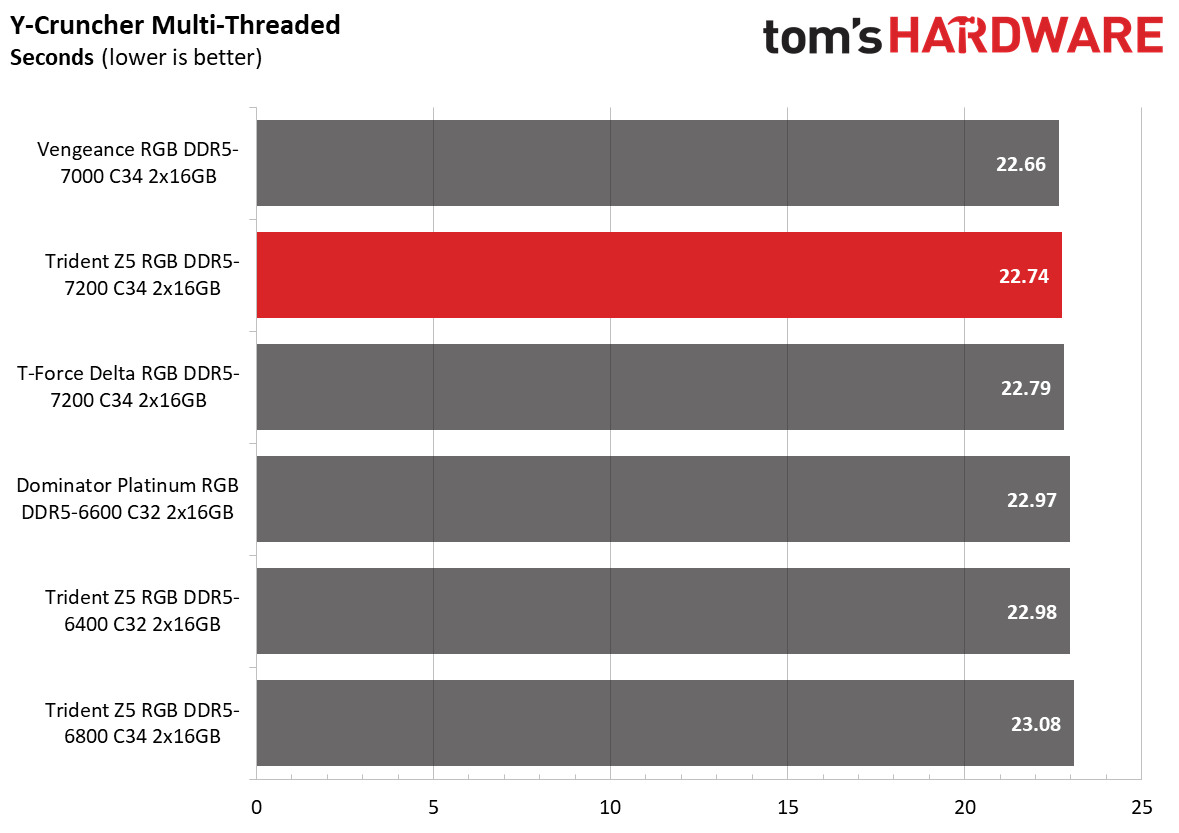
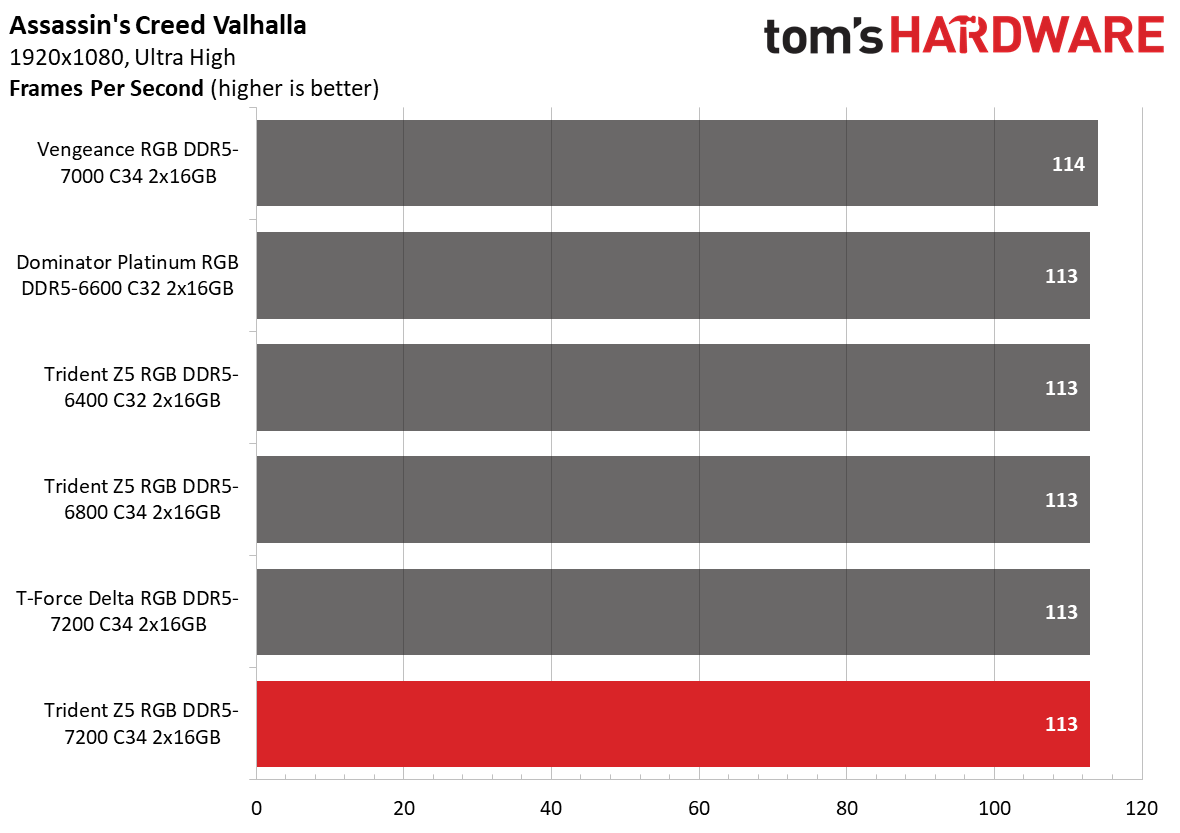
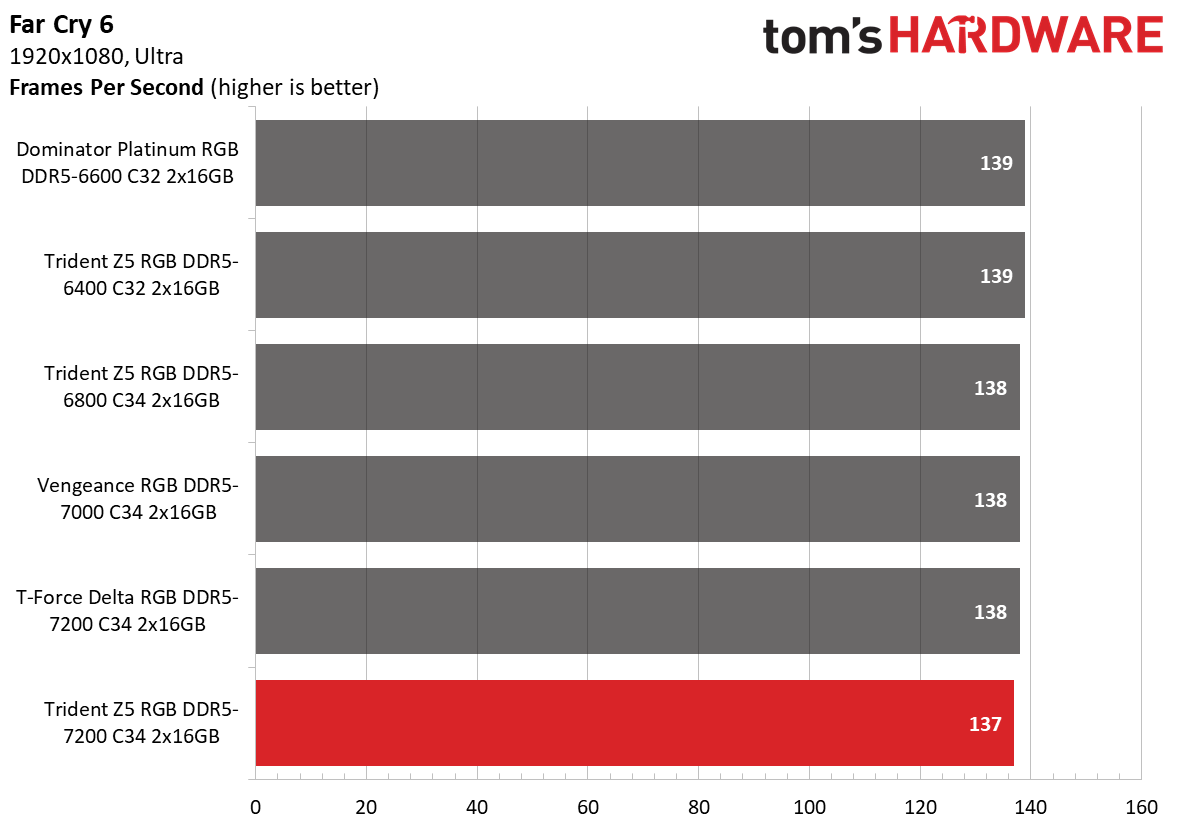
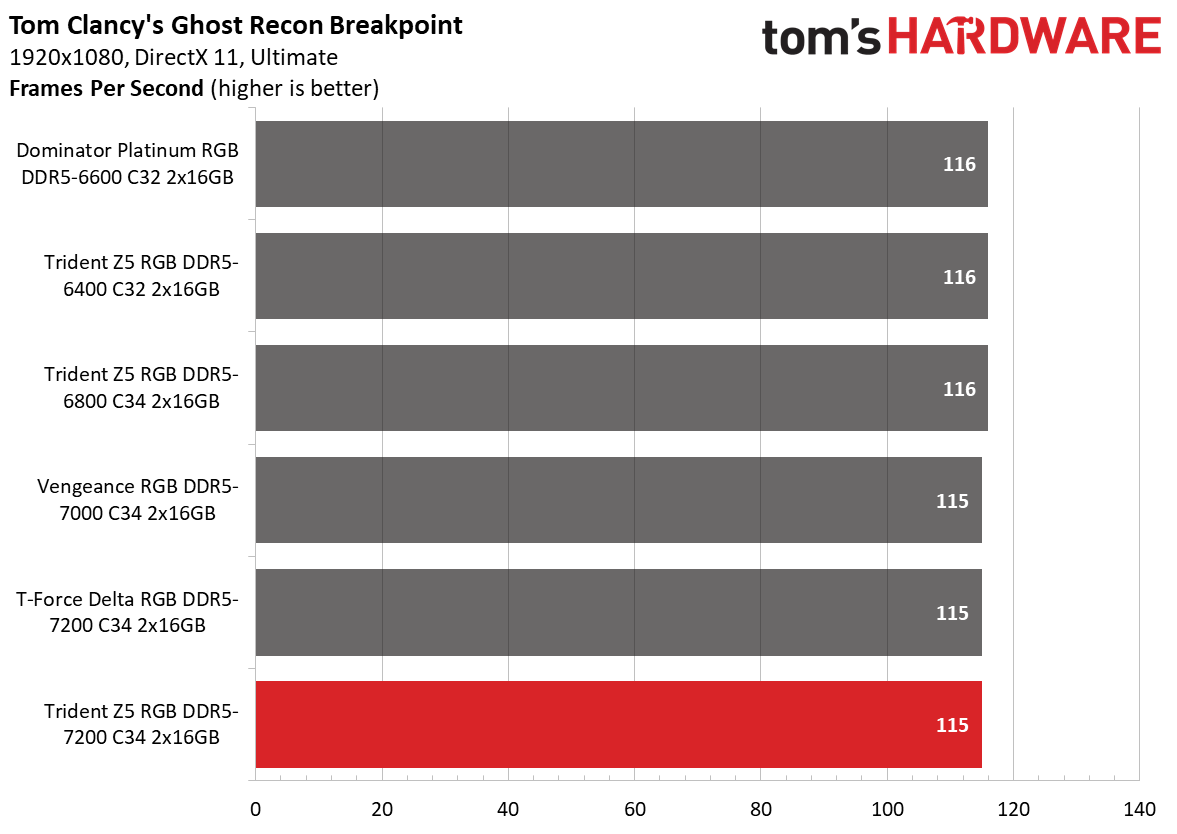
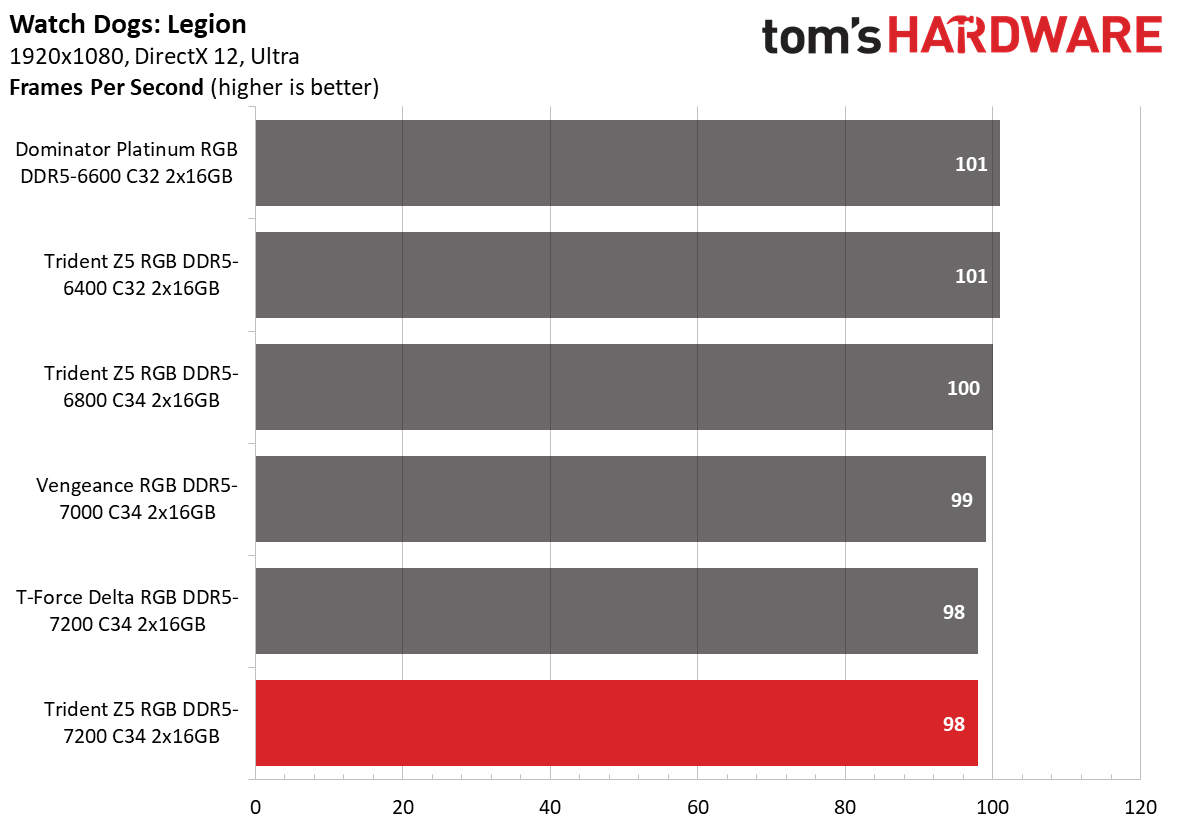
The memory kit exhibited good performance and stable operation during our tests. It placed second overall, outpacing the T-Force Delta RGB DDR5-7200 C34. However, G.Skill's memory kit only took first place in the Adobe Photoshop benchmark, which was 3.2% faster than its T-Force rival.
AMD Performance
The current state of the AGESA code and silicon limitations put AMD's Ryzen 7000 processors at a disadvantage regarding memory support. However, the good samples with a powerful IMC (integrated memory controller) typically support DDR5-6400 to DDR5-6600 memory.
For our particular Ryzen 7 7700X, DDR5-6400 is the ceiling, so DDR5-7200 is beyond the bounds of possibility.
Overclocking and Latency Tuning
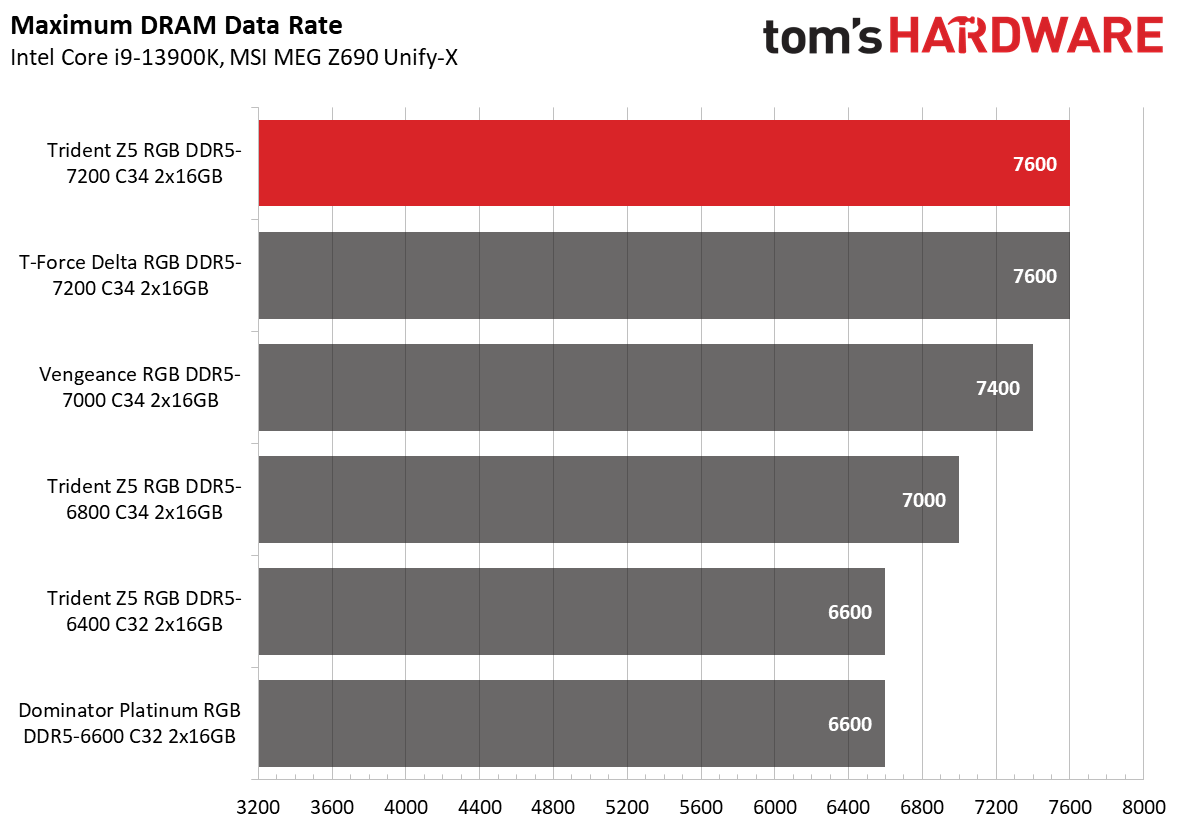
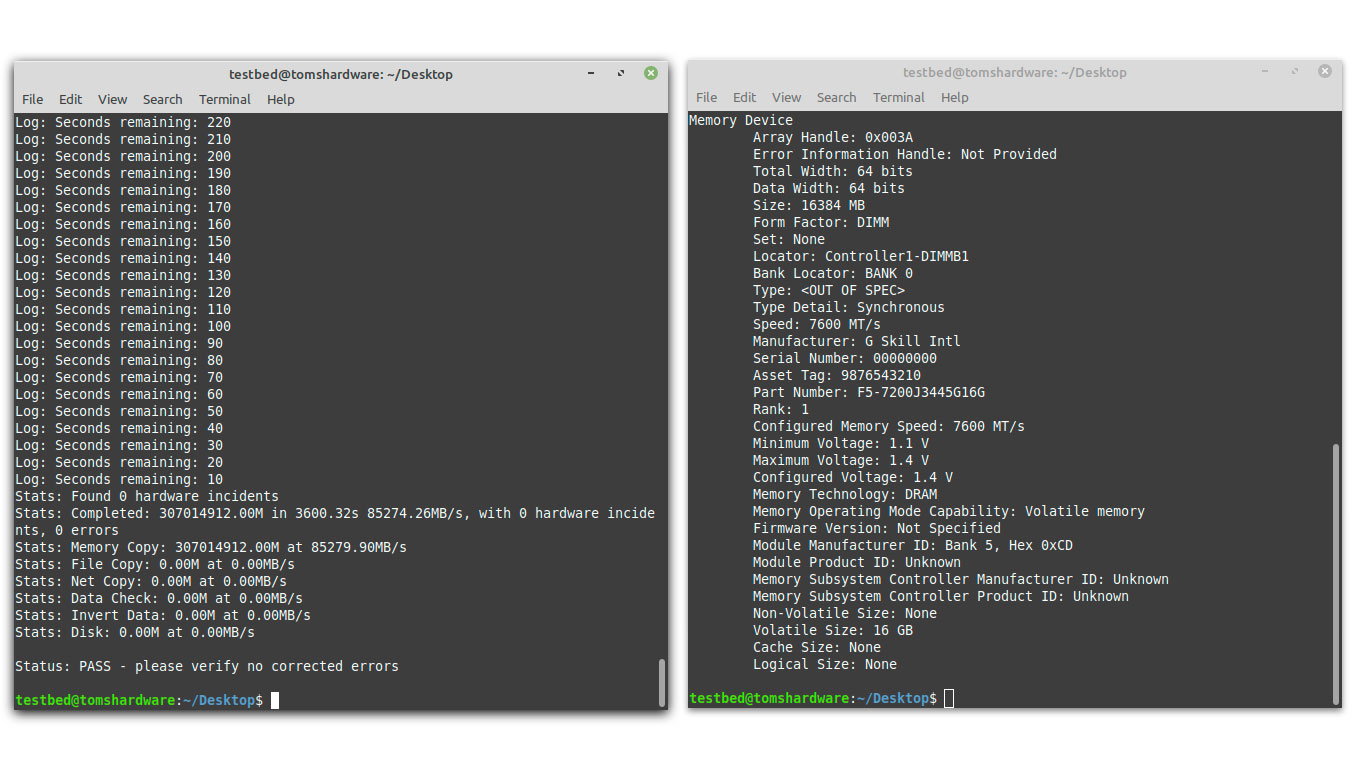
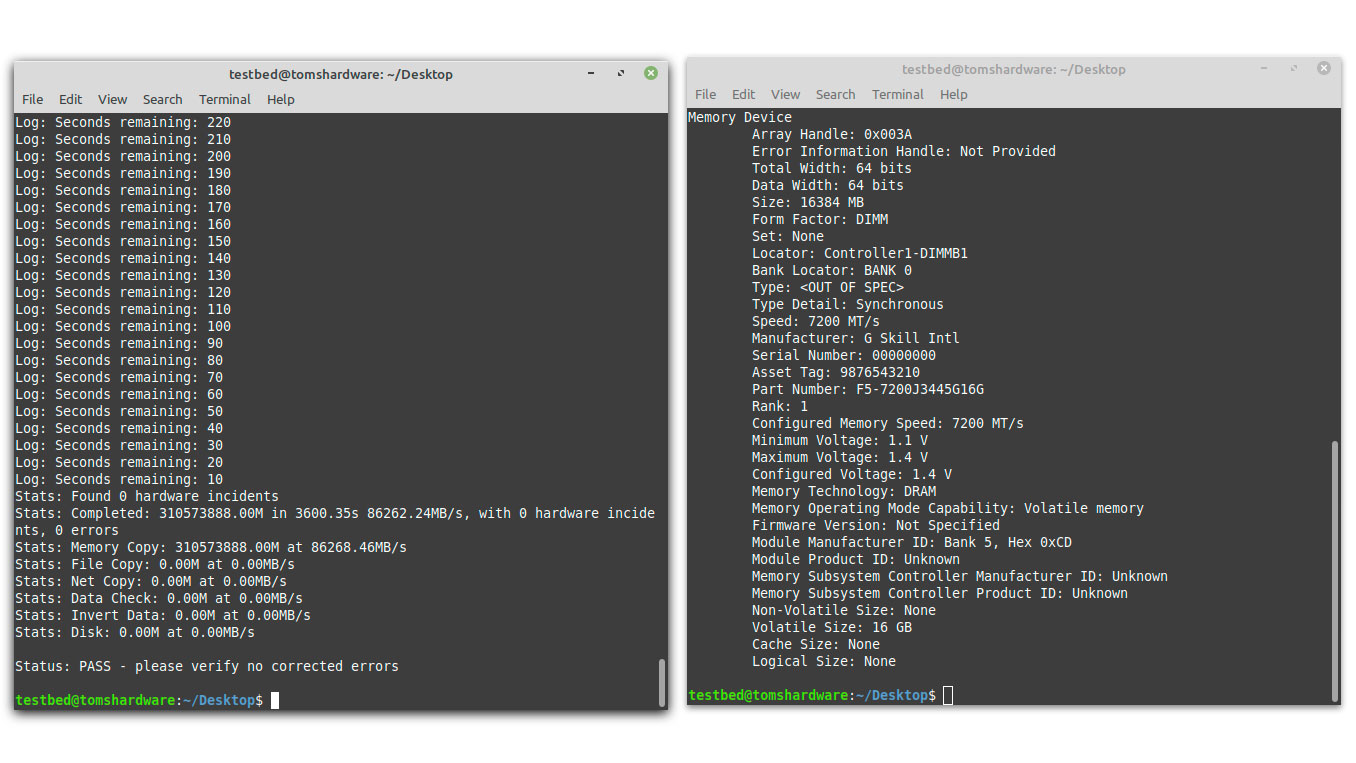
We expected similar headroom from the Trident Z5 RGB memory kit as the T-Force Delta RGB memory kit since both use identical SK hynix A-die ICs. G.Skill's memory modules ran at DDR5-7600 without problems and with the same 1.45V as its rival. The memory timings were comparable, except that the Trident Z5 RGB memory couldn't run stably with the tRAS as 86. As a result, we had to stick to 115, the default tRAS for the advertised speed.
Lowest Stable Timings
| Memory Kit | DDR5-6800 (1.45V) | DDR5-7000 (1.45V) | DDR5-7000 (1.5V) | DDR5-7200 (1.45V) | DDR5-7400 (1.5V) | DDR5-7600 (1.45V) |
|---|---|---|---|---|---|---|
| TeamGroup T-Force Delta RGB DDR5-7200 C34 | N/A | N/A | N/A | 34-41-41-81 (2T) | N/A | 36-46-46-86 (2T) |
| G.Skill Trident Z5 RGB DDR5-7200 C34 | N/A | N/A | N/A | 34-41-41-81 (2T) | N/A | 36-46-46-115 (2T) |
| Corsair Vengeance RGB DDR5-7000 C34 | N/A | N/A | 32-42-42-96 (2T) | N/A | 34-42-42-96 (2T) | N/A |
| G.Skill Trident Z5 RGB DDR5-6800 C34 | 32-42-42-96 (2T) | 34-45-45-108 (2T) | N/A | N/A | N/A | N/A |
However, at DDR5-7200 and with 1.45V, the Trident Z5 RGB managed to get on the same page as the T-Force Delta RGB. We used the exact memory timings of 34-41-41-81, and the G.Skill memory kit ran rock solid.
Bottom Line
The Trident Z5 RGB DDR5-7200 C34 offers slightly better overall performance than the T-Force Delta RGB DDR5-7200 C34. The overclocking potential was similar on both memory kits, which was expected since the two employ practically the same SK hynix A-die ICs. Unfortunately, there is a bit of a lottery to the quality of the ICs. We managed to push the memory to DDR5-7600, but your overclocking mileage will likely vary. But one thing is certain: A-die is currently the best DDR5 IC for hitting high frequencies.
G.Skill sells the Trident Z5 RGB DDR5-7200 C34 for $234.99. Its direct competitor, the T-Force Delta RGB DDR5-7200 C34, retails for $214.99. At the current pricing, there's a noticeable difference. However, that doesn't take away the fact that G.Skill's memory kit is the faster of the two memory kits. The Trident Z5 RGB DDR5-7200 C34 is the way to go if you want pure performance. Aesthetics, as usual, are subjective, and brand loyalty also plays a role in the purchase decision.
- MORE: Best RAM
- MORE: DDR DRAM FAQs And Troubleshooting Guide
- MORE: All Memory Content

Zhiye Liu is a news editor and memory reviewer at Tom’s Hardware. Although he loves everything that’s hardware, he has a soft spot for CPUs, GPUs, and RAM.
-
biruja It would be interesting to see an article that compared various secondary timings too. In my experience, tREFI makes a bigger difference than 200 and sometimes 400 MHz of greater clocks. I'd also show results in AIDA64.Reply